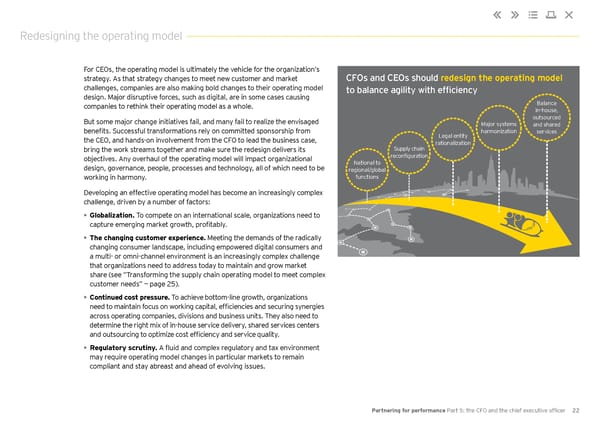Redesigning the operating model For CEOs, the operating model is ultimately the vehicle for the organization’s CFOs and CEOs should redesign the operating model strategy. As that strategy changes to meet new customer and market challenges, companies are also making bold changes to their operating model to balance agility with efficiency design. Major disruptive forces, such as digital, are in some cases causing companies to rethink their operating model as a whole. Balance in-house, But some major change initiatives fail, and many fail to realize the envisaged outsourced Major systems and shared benefits. Successful transformations rely on committed sponsorship from Legal entity harmonization services the CEO, and hands-on involvement from the CFO to lead the business case, rationalization bring the work streams together and make sure the redesign delivers its Supply chain objectives. Any overhaul of the operating model will impact organizational reconfiguration design, governance, people, processes and technology, all of which need to be National to regional/global working in harmony. functions Developing an effective operating model has become an increasingly complex challenge, driven by a number of factors: • Globalization. To compete on an international scale, organizations need to capture emerging market growth, profitably. • The changing customer experience. Meeting the demands of the radically changing consumer landscape, including empowered digital consumers and a multi- or omni-channel environment is an increasingly complex challenge that organizations need to address today to maintain and grow market share (see “Transforming the supply chain operating model to meet complex customer needs” — page 25). • Continued cost pressure. To achieve bottom-line growth, organizations need to maintain focus on working capital, efficiencies and securing synergies across operating companies, divisions and business units. They also need to determine the right mix of in-house service delivery, shared services centers and outsourcing to optimize cost efficiency and service quality. • Regulatory scrutiny. A fluid and complex regulatory and tax environment may require operating model changes in particular markets to remain compliant and stay abreast and ahead of evolving issues. Partnering for performance Part 5: the CFO and the chief executive officer 22
 Partnering for Performance Part 5 Page 23 Page 25
Partnering for Performance Part 5 Page 23 Page 25